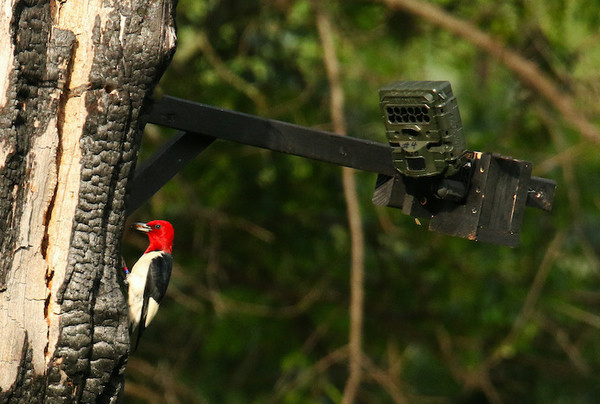
Woodpecker Cavity Cam
Study interactions at red-headed woodpecker nests
- Ongoing
More Information
Help researchers explore the drama-filled world of red-headed woodpecker cavities and the animals that use them!
Red-headed woodpeckers (Melanerpes erythrocephalus) are a charismatic, easily recognizable bird species of the Midwestern and Eastern U.S. Although they were formerly common throughout their range, they have undergone dramatic regional declines estimated at 67% since 1970. This population decline is presumably due to the loss of preferred nesting habitat in open woodlands and savanna-like grasslands that contain dead limbs and snags for nesting and roosting. And despite their conspicuous nature and former abundance, there is a a lot we still don’t know about their biology and life history – including nesting ecology, parental behavior, juvenile dispersal and survival, and migration patterns.
In Minnesota, fragmented patches of red-headed woodpecker habitat exist throughout the state, and there is considerable interest and effort to preserve and restore these areas. In particular, land managers are focused on oak savannas, which are now incredibly rare ecosystems throughout the U.S. and are considered to be one of the rarest ecosystems worldwide. Efforts to support red-headed woodpeckers and other oak savanna specialist species through habitat restoration are ongoing at a number of sites, but these initiatives have been challenged by a general lack of information on the factors that make savannas desirable for this species.
Fortunately, red-headed woodpeckers occur in relatively stable numbers (>100 breeding adults annually) at Cedar Creek Ecosystem Science Reserve in east central Minnesota, which provides a unique opportunity to study an apparently stable population. Building on volunteer monitoring work begun in 2008, a team of researchers led by Dr. Elena West began additional work in 2017 to address key information gaps about red-headed woodpecker ecology. In particular, this work places an emphasis on identifying the aspects of oak savanna habitat that support nest success and survival, habitat use, migration, and movement patterns.
The Woodpecker Cavity Cam sub-project began in 2019 to augment this ongoing research and fill additional knowledge gaps. We are interested in further understanding red-headed woodpecker nesting ecology, with an emphasis on how adult nesting behaviors shape nest success, and how this may be impacted by nest predators and competition by other animals.
Red-headed woodpeckers are important primary-cavity nesters—they excavate holes in trees for nesting and roosting. These cavities are also a vital resource for other animals, including bats, squirrels, tree frogs, mice, and secondary cavity nesting birds, like nuthatches, blue birds, and chickadees. These secondary cavity users do not create cavities themselves, but depend on their availability for breeding and roosting. Through the Woodpecker Cavity Cam Project, we hope to gain a better understanding of the animals that use and compete for these cavities and how they use them throughout the year. To do this, we installed a series of trail cameras near red-headed woodpecker cavities to capture the behaviors and interactions of the community of animals that depend on these holes. With your help going through the videos that the cameras capture, we hope to learn lots of valuable new information!
As a volunteer on this project, you will help us quickly identify which of our thousands of videos contain wildlife, which wildlife are featured, and what they are doing. Our project has three nested workflows, or series of tasks, for volunteers to contribute to. Depending on where we are in the process of collecting and uploading videos, one or more of these workflows may be active. You can see the currently active workflows by looking for the labeled buttons halfway down the main homepage. Depending on the workflow you select, you may be helping us sort out videos with wildlife from those without, identifying animals and documenting their behavior, or providing individual-level data on banded red-headed woodpeckers. Each workflow is essential to our project and to our understanding of life at woodpecker nest cavities. Volunteers’ contributions are valuable no matter where they happen! Feel free to work in the workflow that feels the most rewarding to you, and to switch between workflows as often as you like. Make sure to leave questions and comments about things that are confusing – our team is here to help, and are invested in making sure that you are able to give us the best possible data!
Your work is important to the success of the Woodpecker Cavity Cam project, and we’re so happy to have you with us!
Ticket Required: No
Minimum Age: 13
Languages: English
